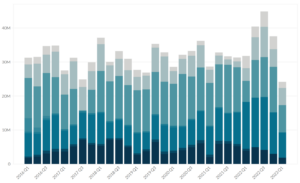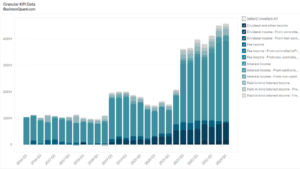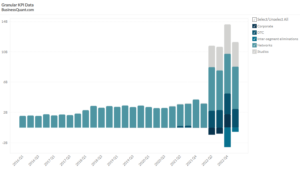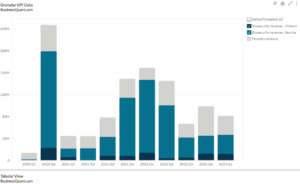
Kohl’s Revenue Breakdown (2016-2023)
Exclusive Data
You need the Pro Plan to access KPI data
- Full access to the platform
- KPI data & segment financials on US stocks
- Financial data on thousands of stocks
- Download data in xlsx and csv formats
Pro Plan
$49 per month*
60% discount ends in:
.
About
More information
Subscribe to Pro or Enterprise plans to unlock this feature.
Contact the Analyst
Subscribe to Pro or Enterprise plans to unlock this feature.
Become a smarter investor today.
Access KPIs & Segment Financials on US stocks
This statistic highlights Kohl’s Revenue Breakdown, split between Net Sales and Other Revenue, reported on a quarterly basis from Q1 2016 onwards.
Kohl’s Revenue Breakdown
| Revenue Breakdown | Q3 2020 | Q2 2021 | Q3 2021 | Contribution in Q3 2021 |
| Net sales | $3,779.0 | $4,223.0 | $4,366.0 | 95% |
| Other revenue | $200.0 | $224.0 | $234.0 | 5% |
| Total | $3,979.0 | $4,447.0 | $4,600.0 | 100% |
(All figures are in millions, except percentages)
There has been an increase in revenue from $3,979 million in Q3 2020 to $4,600 million in Q3 2021, growing approximately by 15.61% on a year-on-year basis. The revenue also grew by 3.44% on a quarter-on-quarter basis, increasing from $4,447 million in Q2 2021 to $4,600 million in Q3 2021.
The business is subjected to seasonal influence where the company earns higher revenue during back-to-school and holiday seasons, that are in the second half of the fiscal year. A fall in revenue during the second half of the fiscal year can adversely affect the yearly results of operations.
Net Sales
Net sales refer to sales of merchandise, net of expected return and shipping revenue. The company sells products such as footwear, accessories, beauty, and apparel via their offline stores and website.
Revenue increased from $3,779 million in Q3 2020 to $4,366 million in Q3 2021, making a growth of approximately 14.74% on a year-on-year basis. Revenue also increased by 3.39% on a quarterly basis, as compared to $4,223 million in Q2 2021. This increase in revenue was driven by higher sales in online and offline stores.
About 29% of the net sales were made over the internet. This shows that the digital penetration rate was 29% of net sales and increased by 6% in Q3 2021. Digital penetration refers to digital sales over net sales. Accessories, footwear, and men’s wear were among the outperformers. Net Sales contribute 95% to the company’s total revenue in Q3 2021.
Other Revenue
Other Revenue consists of revenue from credit card usage, fees paid by third parties for advertising their product on the company’s website, merchandise return cards, and non-merchandise revenue.
Revenue increased from $200 million in Q3 2020 to $224 million, making a growth of 12% on a year-on-year basis. Revenue also grew by 4.46% on a quarterly basis, as compared to $224 million in Q2 2021. This increase was driven by an increase in credit card revenue, which was partially offset by lower account receivables and higher payment rates. The share of revenue remained constant in Q3 2020, Q2 2021, and Q3 2021. Other revenue contributes 5% to the company’s total revenue in Q3 2021.
About Kohl’s
Kohl’s Corporation is an American retail store chain that sells moderately-priced national and private brands of apparel, footwear, accessories, beauty, jewelry, electronics, toys, and home products such as beds, curtains, and other home furniture. The national brands have higher selling prices, but the margins are generally low. Some of the national brands sold by the company are Food Network, L C Lauren Conrad and Simply Vera Vera Wang. Some of the private brands sold by the company are Croft & Barrow, Jumping Beans, SO and Sonoma Goods for Life. The company comprised 1,162 stores and 12 FILA outlets as of January 2021. Kohl’s was founded in 1962 and is headquartered in Menomonee Falls, US. They became the 23rd largest retailer in the US in terms of revenue in 2019 and the 2nd largest US departmental store in the US in terms of retail sales in 2013. The company’s common stock is listed on the NYSE under the symbol “KSS” and is a component of S&P 400 and Fortune 500.
The covid-19 pandemic had a massive impact on the company’s operations. In May 2020, the company opened a number of stores but due to several covid restrictions, they were unable to conduct business in its full capacity. The company had to shut down its retail store (furloughed 85,000 stores) and had to suffer a decline of 20.4% in its sales and gross margins declined 464 basis points. The volatility of demand increased and the global supply chain was disrupted. However the company took several measures to fight the pandemic and increase its revenue. They incorporated certain protocols such as wearing masks inside the store by both employees and customers, social distancing markers, cleaning of high touch surfaces, and protective barriers at registers. The company even reduced the number of operating hours and separated the area for Amazon returns and widening of the aisle by removing the in-aisle fixtures. They focused more on the development of websites and expenditure on digital sale increased.
Did you like Kohl’s Revenue Breakdown statistic?
Access more such KPI data points and segment financials on thousands of US stocks, with Business Quant.
You can get started here.
More data on US Stocks

Our Plans
Always know what you’ll pay. No hidden costs or surprises.
- Annual
- Monthly
60% discount until this Sunday
Pro
For serious investing
-
Company KPI data Access segment financials, non-GAAP metrics and KPI data from presentations and filings. Examples include financials by segment / region / product category, AT&T's broadband subscriber trends, Tesla's deliveries by model and lots more.
-
Stock research tools Features include : stock screener, stock comparison, industry financials, stock warnings, advanced charting tools, timeseries tables, scatter charts, financial statements, stock reports, SEC filings, stock ratings, institutional and insider ownership data. There are 200+ financial items and ratios on thousands of US stocks.
-
Industry data & tools Access premium operating data on 40+ industries. Examples include market share, smartphone shipments by vendor, subscribers by wireless carrier, historical gold production. There are 20,000+ such statistics.
Enterprise
For tailored workflows
-
All of Pro plan Get unfettered access to all our dashboards and dossiers.
-
Custom built features Get tailored dashboards built specially for you , based on your set of requirements, to simplify your research workflow.
-
Admin billing Back-end documentation support and multi-seat licensing.
* Billed annually, local taxes extra.
60% discount on Annual plan
Pro
For serious investing
-
Company KPI data Access segment financials, non-GAAP metrics and KPI data from presentations and filings. Examples include financials by segment / region / product category, AT&T's broadband subscriber trends, Tesla's deliveries by model and lots more.
-
Stock research tools Features include : stock screener, stock comparison, industry financials, stock warnings, advanced charting tools, timeseries tables, scatter charts, financial statements, stock reports, SEC filings, stock ratings, institutional and insider ownership data. There are 200+ financial items and ratios on thousands of US stocks.
-
Industry data & tools Access premium operating data on 40+ industries. Examples include market share, smartphone shipments by vendor, subscribers by wireless carrier, historical gold production. There are 20,000+ such statistics.
Enterprise
For tailored workflows
-
All of Pro plan Get unfettered access to all our features.
-
Custom built features Get tailored dashboards built specially for you , based on your set of requirements, to simplify your research workflow.
-
Admin billing Back-end documentation support and multi-seat licensing.
* Local taxes extra.






